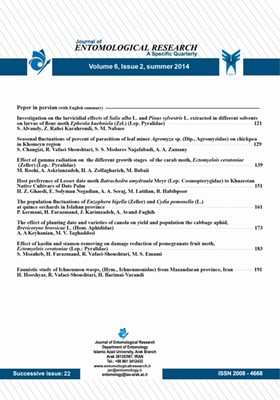The effect of planting date and varieties of canola on yield and population of the cabbage aphid, Brevicoryne brassicae L. (Hom., Aphididae)
Subject Areas : entomology and othea arthropodsA. A. Keyhanian 1 , M. V. Taghaddosi 2
1 - research institute of plant protection, Tehran, Iran
2 - Zanjan Agricultural and Natural Resources Research Center, Zanjan, Iran
Keywords:
Abstract :
The cabbage aphid, Brevicoryne brassicae L. is one of the most important pests of canola which induces serious damage to the crop over the country. Use of resistant varieties along with proper sowing time, are IPM-based methods, which were studied in Saveh fields of Markazi province Iran through growing seasons of 2004-2005 and 2004-2005. We used a layout of split plot design consisting of varieties of RGS003, Licord, PF, and SLM046 (as main plots) and 3 sowing dates of 20 Sep. 5 Oct. and 10 Nov.(as sub plots) at 3 replicates, Natural aphid infection was sufficient. The aphid density was estimated by counting occurance of the pest number on one centimeter of the upper parts of the 10 randomly selected canola stems. Also yields of each plot were measured using a quadrate of 1 ×1m. Results showed that first date of planting (22th Sep.) during both years of study produced significantly highest yield (139.33 & 149.97 kg/ha) respectively but the lowest density of aphids (20.88& 13.05) per sampling unit. The cultivar "RGS003" which yieldied 146.67 and 144.84 kg/ha and attracted 32.56 and 48.67 aphids in both years of study was evaluated as superior cultivar to others. Overall results suggest the date of first planting and "RGS003" cultivar for the region of study.


